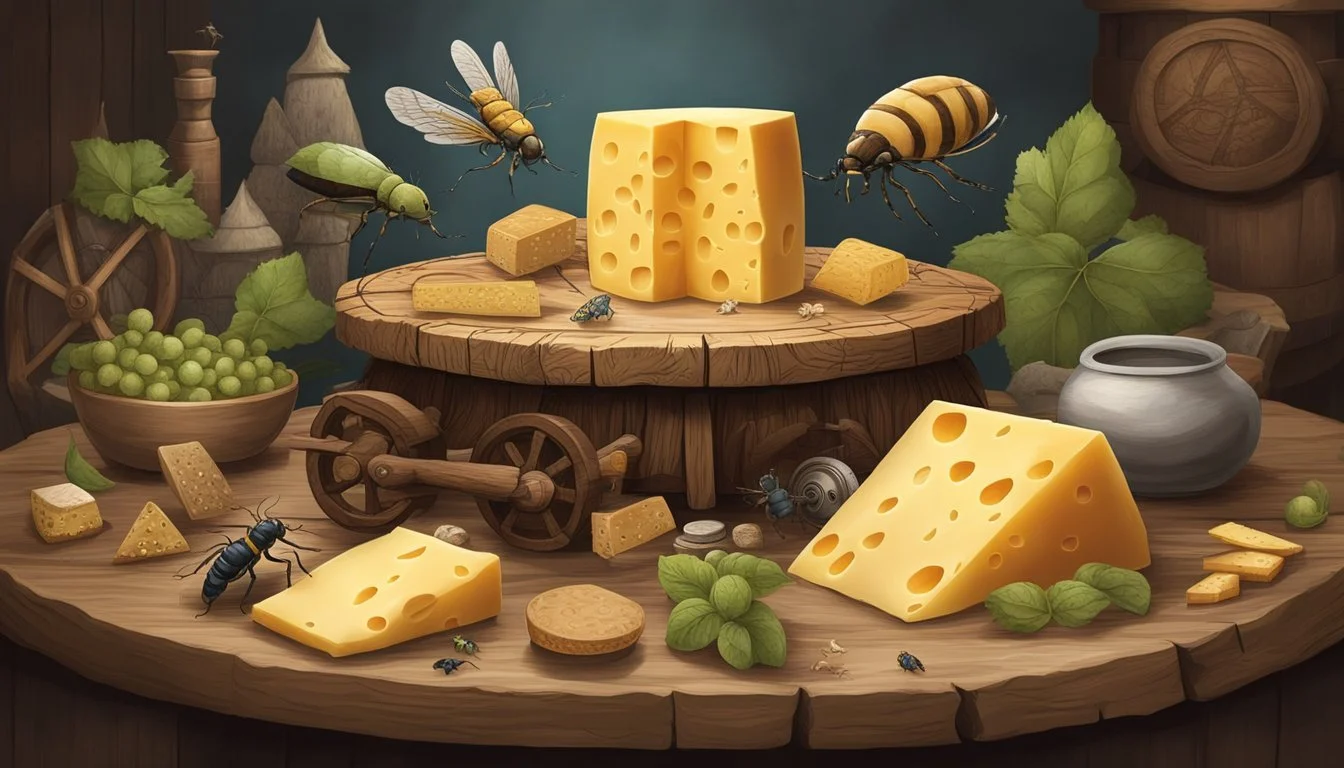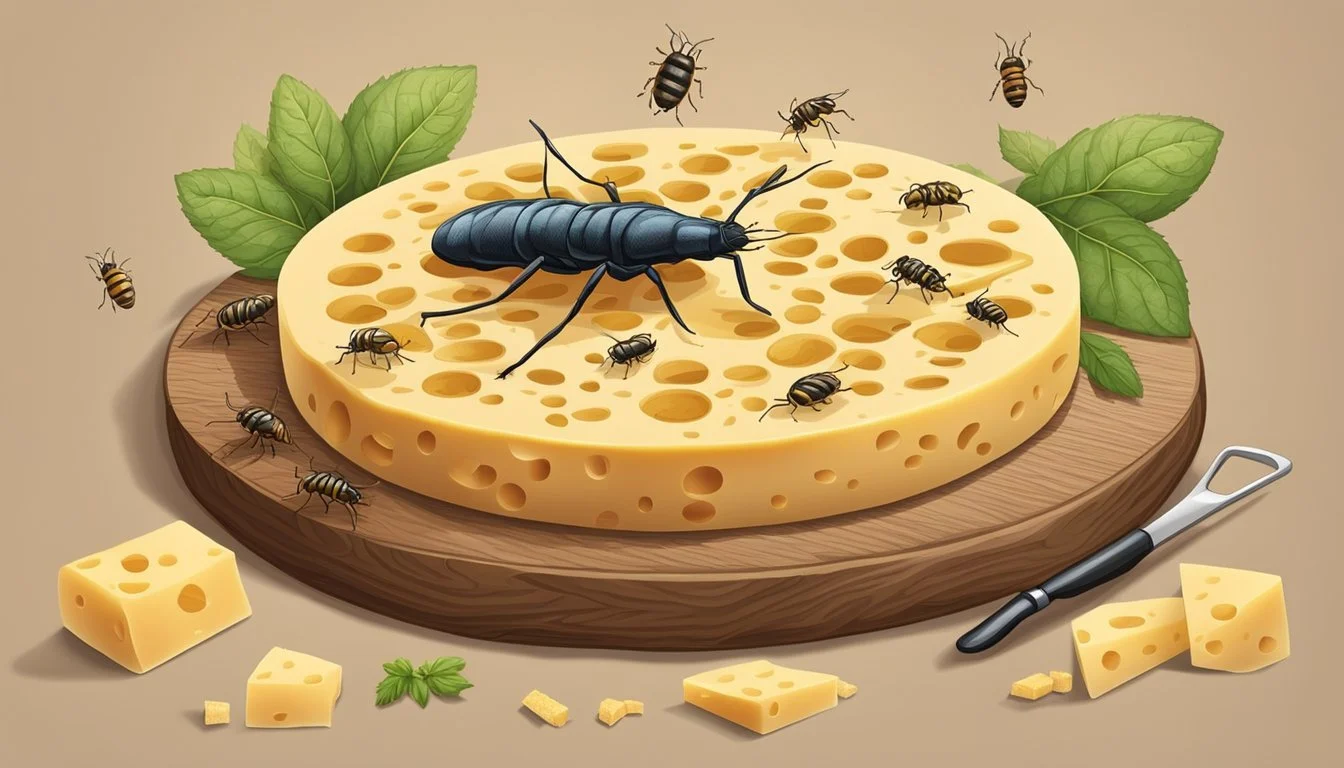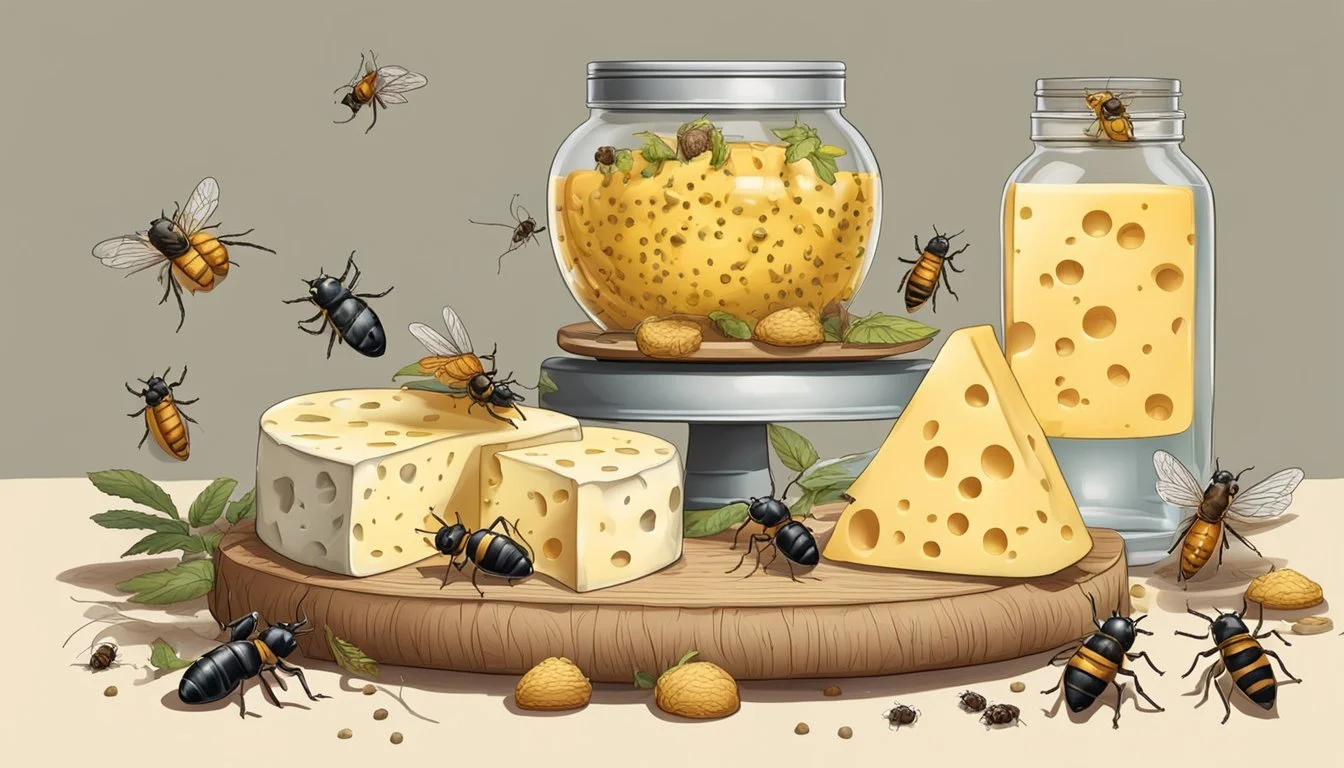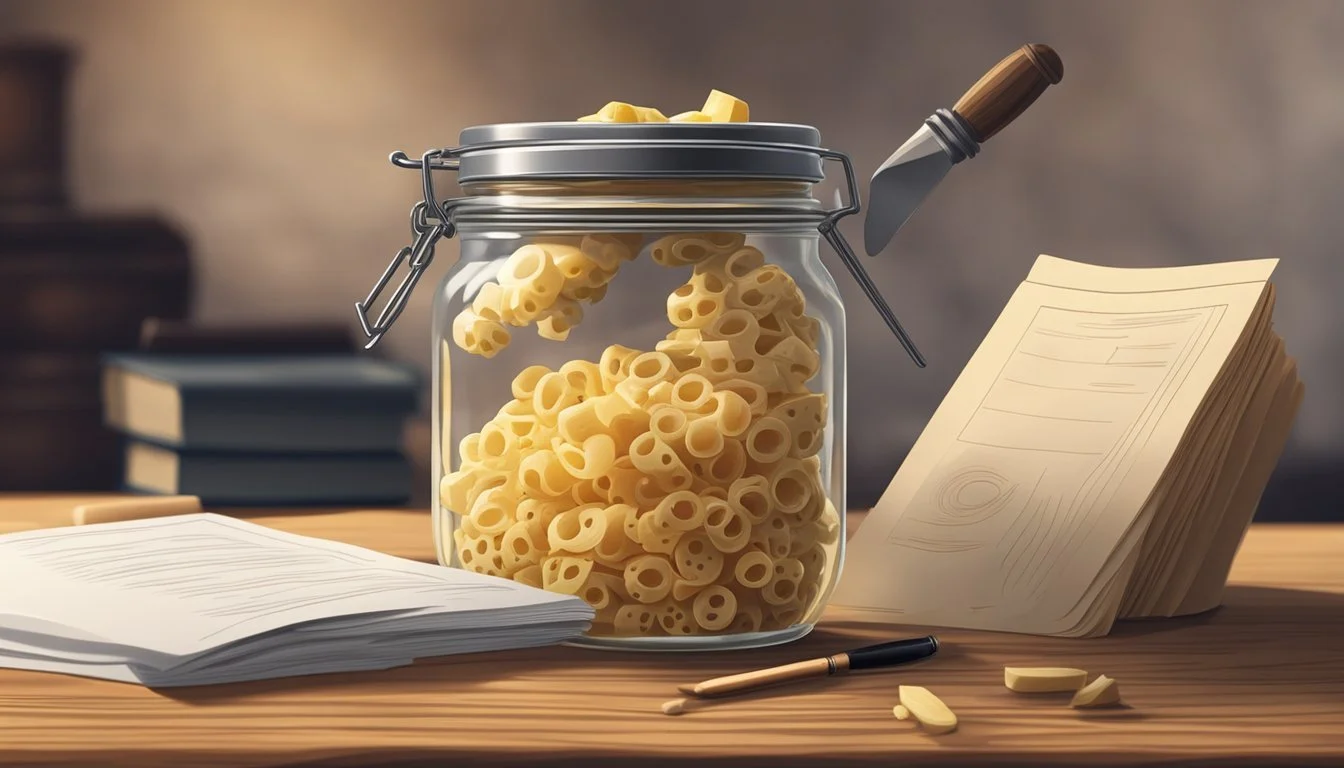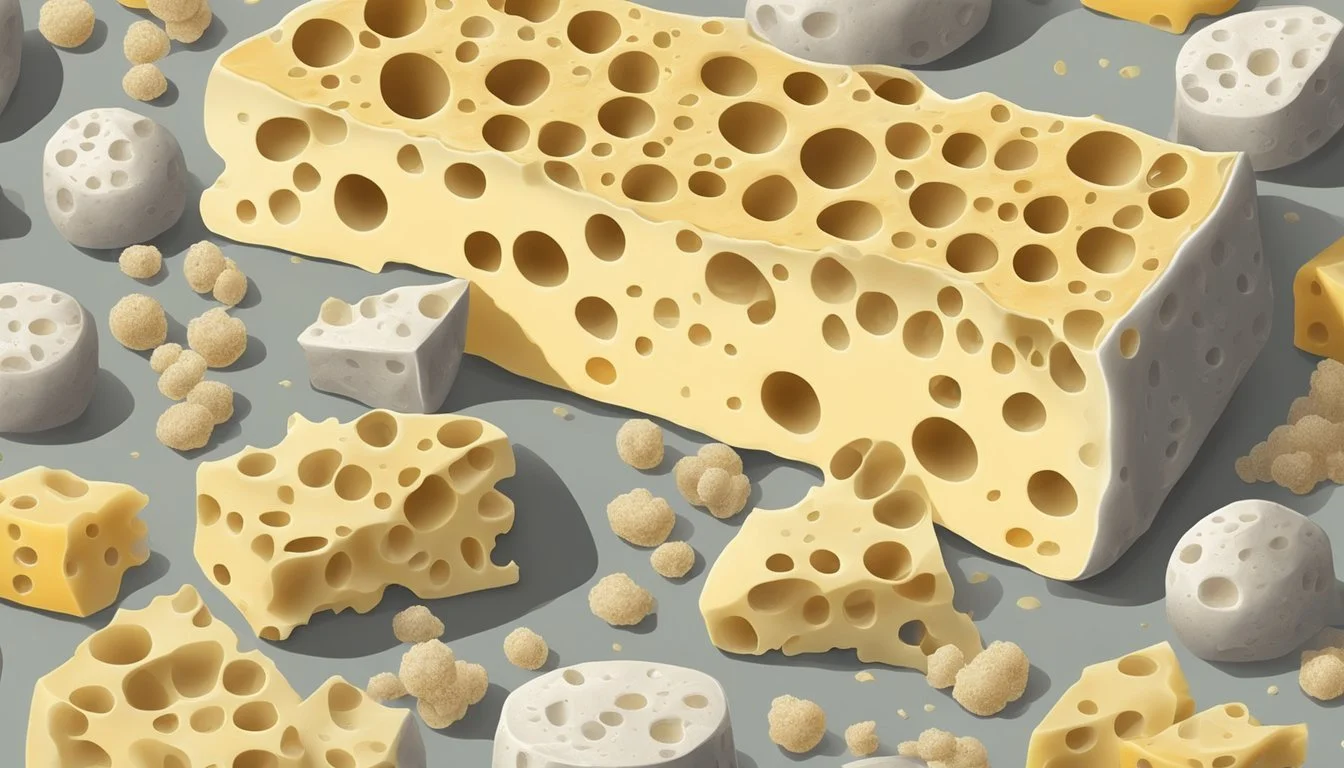Larvae Cheese
A Delve into the World of Insect-Infused Dairy
In a niche that intertwines the world of entomology with culinary tradition, there exists a cheese (What wine goes well with cheese?) unlike any other—infused with live insect larvae. This unique dairy product is not merely an accidental habitat for the larvae of the cheese fly, Piophila casei, but rather a deliberate cultivation of these organisms within the cheese. The larvae are introduced to the cheese, where they begin their lifecycle, and their digestive process plays a pivotal role in achieving the distinctive creamy texture and intense flavor that this cheese is known for.
This cheese, referred to by names like casu marzu in Sardinia, incorporates the larvae which are integral to its creation and identity. The maggots feed on the cheese, breaking down its fats and transforming the product into a spreadable and potent delicacy. Despite its controversial nature and the health concerns that come with consuming live larvae, this cheese has a revered status among certain food aficionados. The consumption of the cheese, complete with wriggling larvae, is a practice steeped in tradition that continues to provoke both fascination and apprehension in equal measure.
While it might challenge the palates and sensibilities of the uninitiated, the presence of insect life in cheese reflects an age-old harmony between human culinary traditions and the natural world. The intricate process resulting in this cheese's unique identity is a testament to the lengths gastronomes will go to in order to cultivate flavors that are as complex as they are exotic. As such, it remains a sought-after experience for adventurous cheese lovers, marking the intersection of nature's work and human innovation in gastronomy.
Cultural and Historical Context
This section delves into the origin of a distinctive cheese that incorporates live insect larvae and its significance within particular European cultures, focusing on Sardinia and Corsica.
Origins in Sardinia and Corsica
Casu marzu originates from the Italian islands of Sardinia and Corsica. It evolves from Pecorino cheese, a well-established Italian cheese made from sheep's milk. Over time, islanders in these regions developed a unique method of aging the cheese to create something truly unique, which blurs the lines between traditional cheese fermentation and a process that involves the active participation of insects.
Traditional Sardinian Delicacy
In Sardinia, casu marzu has transcended its origins to become a traditional delicacy. This cheese is characterized by the live larvae of the cheese fly, Piophila casei, which are intentionally introduced. The larvae's digestion of the cheese fat results in a soft, creamy texture and strong, distinctive flavors that are coveted by local connoisseurs. This process, while controversial, reflects a historical facet of Sardinian food culture that challenges modern food safety regulations, such as those enforced by the European Union. The cheese's legal status has been in flux, with traditionalists arguing for its cultural significance against broader food safety concerns.
The Making of Larvae Cheese
Larvae cheese, traditionally known as Casu Marzu, undergoes a unique process of fermentation that incorporates live insect larvae. This distinctive method not only affects the texture and flavor of the cheese but also highlights a singular intersection between gastronomy and nature.
Pecorino Cheese as a Base
The initial stage in producing larvae cheese begins with Pecorino, a well-known Italian cheese made from sheep's milk. Pecorino serves as the foundational cheese, which is crafted following conventional cheesemaking methods. The process starts with the milk being heated and coagulated using rennet. Once curdled, the curds are pressed and molded, creating wheels of cheese intended for further maturation.
Role of Piophila casei
The defining feature of larvae cheese is the introduction of Piophila casei, commonly known as the cheese fly. Upon the rind forming on the Pecorino wheel, the cheesemaker creates small openings to allow the Piophila casei to lay eggs inside the cheese. These eggs eventually hatch into larvae, which play a crucial role in the fermentation process. The larvae consume the cheese's fats, leading to a softening of the cheese body and contributing a distinctive creamy texture. It is during this period that the unique flavors of larvae cheese are developed, as the larvae's activity stimulates a level of fermentation beyond what is achievable with Pecorino alone.
Flavour Profile
Larvae cheese showcases a flavor that is as unique as its production method. This cheese's distinctive characteristics are primarily derived from its process of fermentation and the influence of insect larvae.
Decomposition and Texture
Through the process of decomposition, larvae cheese acquires a soft, creamy texture that contributes to its unique sensory experience. The larvae of the cheese fly, Piophila casei, feed on the cheese, breaking down its fats. This action not only softens the cheese but also imparts a flavor profile that ranges from mildly tangy to intensely piquant, with some descriptions including a nutty edge. The interaction between larvae and cheese creates a product that is soft and creamy, a direct result of the larvae's digestive process.
Pairing with Beverages
When it comes to pairing larvae cheese with beverages, a strong, robust wine is often chosen to complement its assertive flavors. Typically, a full-bodied red wine is selected for its ability to stand up to the intense flavor profile of the cheese. The cheese's pronounced taste, enhanced by the maturation process involving live larvae, pairs well with wines that exhibit bold, rich qualities. Here is a simple guide for pairing:
Full-bodied red wine: Characteristics - Robust, rich flavors; Reason for Pairing - To balance the strong flavors of the cheese
Traditional Sardinian red wine: Characteristics - Bold, persistent character; Reason for Pairing - To complement regional cheese variants
Selecting the right wine enhances both the flavor of the larvae cheese and the tasting experience by creating a harmonious balance on the palate.
Health and Consumption
When considering the consumption of larvae cheese, it's essential to assess its impact on health, examining both its potential nutritional benefits and the health concerns it may pose.
Potential Benefits
Larvae cheese, like other dairy products, contains protein and fats that are crucial for a variety of body functions. The larvae in the cheese are said to break down the cheese fats, making it soft and creamy. Additionally, the digestive process of the larvae could potentially enhance the cheese's fermentation, contributing to the unique flavor and possibly increasing the bioavailability of proteins.
Health Concerns
However, health concerns related to larvae cheese are significant. Consumption of this cheese can lead to health issues such as nausea, diarrhea, and allergic reactions. Live larvae within the cheese could survive in the human digestive system and cause myiasis, an infection where larvae infest and develop in human tissue. This poses a genuine health risk, and thus, certain regulations ban the commercial sale of larvae-infested cheese.
Regulatory and Legal Status
In the landscape of food regulation, the legal status of cheeses like Casu Marzu—which contain insect larvae—is complex, particularly within the European Union which maintains stringent food safety standards.
European Union Regulations
The European Union has established comprehensive food safety regulations to protect consumers. Casu Marzu falls into a legal gray area under these rules due to its unconventional production process involving live larvae. While traditional cheeses are celebrated under EU laws that recognize Protected Designation of Origin (PDO) products, Casu Marzu has historically faced challenges, as it does not conform to the hygienic standards required by the EU for foods.
The potential health risks posed by the consumption of foodstuffs with live insects have led to debates about such cheeses' safety and legal status. Specifically, laws intended to safeguard the food chain consider the presence of live parasites in food potentially unsafe. This concern has impacted the legal status of cheeses like Casu Marzu, prompting periodic bans and restrictions.
Unauthorized Sales and the Black Market
Despite the restrictions, there exists a black market for Casu Marzu and similar cheeses. Demand for these products persists, driven by cultural traditions and the cheese's unique flavors. Sellers and buyers often resort to unauthorized channels to procure and sell this cheese, circumventing official regulations. The black market can result in the cheese being traded in conditions that are not regulated for safety, which potentially increases health risks for consumers.
Environmental and Ethical Considerations
In the unique domain of larvae cheese production, environmental sustainability and ethical practices come to the forefront, challenging traditional norms and striking a balance between novel food trends and responsible consumption.
Sustainability of Insect Infusion
Incorporating insects into cheese production taps into a practice known as entomophagy, the consumption of insects as food. This is a sustainable alternative protein source, utilizing significantly less water and land compared to traditional livestock. Insects, such as the cheese fly larvae used in larvae cheese, produce a lower carbon footprint and are considered a resource-efficient way to infuse nutrients into cheese.
Resource Usage for Insect Rearing vs. Livestock Farming:
Water: Insects require minimal water for survival.
Land: Insects can be farmed vertically, reducing land usage.
Feed Efficiency: Insects convert feed into protein more efficiently than cattle or poultry.
Entomophagy and Future Diets
The infusion of edible insects into diets, particularly within Western societies that have not historically embraced entomophagy, presents both a challenge and an opportunity. It raises questions about the acceptability of such novel foods but also highlights the nutritional benefits, as insects are rich in proteins, vitamins, and minerals. As global populations rise and demand for protein increases, sustainable alternatives like insect-infused foods could play a crucial role in future diets.
Nutritional Benefits of Edible Insects:
High in essential amino acids
Source of vitamins such as B12 and minerals like iron and zinc
The ethical considerations in producing larvae cheese are inherent in its sustainability attributes. By focusing on less-intensive farming practices and resource efficiency, the cheese industry can mitigate environmental impacts and support a move towards more ethical consumption patterns.
Larvae in Other Culinary Contexts
In various global cuisines, insect larvae and other edible insects play a role that extends beyond their use in cheeses like Casu Marzu. They are not only a source of nutrition but also traditional elements in cultural diets.
Edible Insects Beyond Cheese
Throughout history, edible insects—whether larvae, ants, or other arthropods—have been consumed for their protein, fat, and mineral content. Entomophagy refers to the practice of eating insects, a tradition that has been part of human diets for centuries and is common in many parts of the world. Beyond larvae-infused cheese, some cultures enjoy insect larvae in dishes such as Mexico's escamoles, which are ant larvae harvested from the roots of the agave plant. These are often referred to as "insect caviar" and are considered a delicacy. In parts of Asia, silkworm larvae are eaten as a snack, boiled or deep-fried, and seasoned with various spices.
International Consumption Trends
The consumption of insects, including maggots and larvae, reflects a culinary tradition that varies widely across different cultures. Here are a few notable examples highlighting international consumption trends:
Africa: Mopane worms, the caterpillar of the Emperor moth, are harvested, dried, or smoked and then eaten in various African nations.
Asia: In Thailand, street vendors sell a variety of deep-fried insects, including bamboo larvae, which are a common snack.
Australia: Witchetty grubs, the larvae of cossid moths, are traditional bushfood for Indigenous Australians.
South America: In Colombia, leaf-cutter ant queens, known as "hormigas culonas," are collected and roasted, often eaten as part of local festivals.
Travel often involves discovering these local practices and cuisines, where insects and their larvae are not seen as pests but as valuable components of the diet. Those interested in sustainable animal protein sources frequently study these practices, given the lower environmental impact of farming insects compared to larger animals.
Scientific and Forensic Study
The Piophila casei larvae and their predictable developmental cycles are crucial in forensic investigations, particularly in establishing time since death during decomposition stages.
Piophila casei in Research
Piophila casei, also known as the cheese skipper, plays a significant role in forensic entomology. Given its life cycle, forensic researchers can use the presence of these larvae to estimate the postmortem interval (PMI), which is the time elapsed since death. These estimations are grounded on the larvae's developmental stages that are affected by environmental conditions, primarily temperature.
For instance:
Egg Stage: P. casei eggs are pearl white and hatch within 23 to 54 hours at 15° to 27°C.
Active Larvae: Upon hatching, the larvae immediately become active. They are known for their ability to 'skip,' propelling themselves into the air.
Research documents specific durations for each life stage of P. casei, facilitating their use as time markers in forensic cases.
Understanding Decomposition
Decomposition is a complex process, catalyzed by bacteria and insects like Piophila casei. These insects are detritivores, meaning they feed on decaying organic matter, thus accelerating the breakdown of tissues. The progression of decomposition and the activity of such insects are meticulously documented to understand changes over time.
Timeline of decomposition involving Piophila casei:
Initial Infestation: Occurs shortly after death, with flies depositing eggs on the body.
Larvae Emergence: Larvae hatch and begin feeding, contributing to decomposition.
Pupal Stage: Larvae develop into pupae, leading to the emergence of adult flies that can propagate the cycle.
By assessing the presence and developmental stage of P. casei within a decaying organism, forensic experts can estimate the time since death, which is a critical aspect of legal investigations. The predictability of this process allows for a reliable utilization of these organisms in forensic science.
Interesting Facts and Trivia
Larvae Cheese, also known as Casu Marzu, is a distinctive type of cheese known for its live insect infusion. This Sardinian specialty incorporates the cheese fly, or cheese skipper, in its aging process for an unconventional transformation.
Cheese Skipper in Pop Culture
The cheese skipper, a type of cheese fly, has found its way into pop culture due to its role in the creation of Casu Marzu. Rare appearances in television and culinary adventure shows have brought this tiny insect into the limelight.
Notable Appearance: Bizarre Foods with Andrew Zimmern
Cultural Reaction: Mixed intrigue and revulsion
Recordings of Exotic Uses
Aphrodisiac Claims: Some enthusiasts of Casu Marzu believe in its aphrodisiac properties, although these claims are based more on folklore than scientific evidence.
Sardinia: Exotic Use - Traditional Delicacy; Note - Served with Pane Carasau (flatbread)
Mediterranean: Exotic Use - Rare Ingredient; Note - Sought-after for marcetto
Marcetto is a similar Italian cheese variant that also features live larvae. Chefs and connoisseurs who value unique food experiences often seek out such cheeses for their bold flavors and textures.


